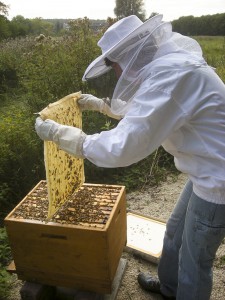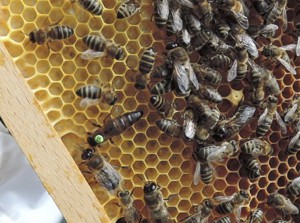SB is a relatively new and dedicated beekeeper in southern Germany. She is interested in different kinds of bees and their place in the ecological system. I asked her to tell her story and her struggles helping her bees to survive and thrive on their own as much as possible without chemicals. She writes:
After watching wild bees for some years I wanted to have honeybees and took lessons given by an organic beekeeper. In the year 2014 I bought my first colony from him. It was a Carnica cross on natural comb, built by the bees without the help of wax foundation. They had been treated with oxalic and formic acid against the varroa. But they were sick anyway!
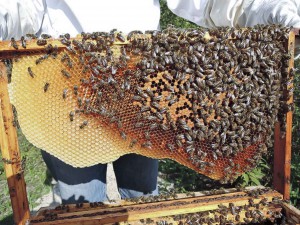 My first colony was a Carnica (Carniolan) colony on natural comb.
My first colony was a Carnica (Carniolan) colony on natural comb.
I tried to find a way out of this chemical strategy that seemingly didn’t help. I got some information on internet and started watching how bees defend themselves against illnesses. I don’t want to have them close to other bees. I tried to help them with sugar powder dusting to rid them of the mites sitting on bees. After treatment with formic acid in summer, they had a natural downfall of 30 mites per day. After sugaring the whole hive ten times with 2 days in between the natural downfall of mites were 5 per day. This involved a lot of work and still didn’t do the job. The bees had chalk brood too!
I measured cell size on their natural comb. It was 5.0 mm in the brood area, 5.4 in food area and drone cells began at 5.6. All honey was taken when harvested, so they lived on sugar syrup for a long time of the year. They died in february 2015, not having enough bees to warm the hive!
I had found some contacts through internet and was able to get 4 hives in 2015 which weren`t treated with chemicals for some years. One was of the dark bee Apis mellifera mellifera (AMM) , three were Carnica (Carniolans). I made some splits and wintered 3 of the AMM origin and 5 of the Carnica origin.
The former owner had a crisis being the victim of a migratory beekeeper whose hives most probably caused reinfestation bringing a lot of mites into his hives. He overcame this crisis combining the weakest of his hives, so they became strong enough to defend themselves. Some survived. In some of these he introduced a AMM variety of queens that had a reputation of being more resistant.
My aim was to follow Dee Lusby`s in Arizona way of beekeeping as much as possible (http://beesource.com/point-of-view/dee-lusby). Using small cell foundation, leaving with the bees enough honey for food, using so called housel position of the combs, what she calls unlimited broodnest and using no treatment (if possible).
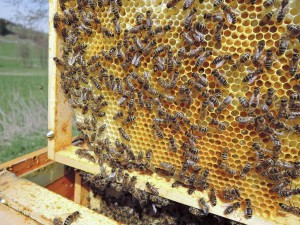 Now I have 11 colonies and high hopes.
Now I have 11 colonies and high hopes.
All 8 hives survived winter, but in spring 2016 I had to eliminate one of them because its bees were too susceptible to virus (another than DWV). I have made some splits and have now in May 11 hives and high hopes. The bees are my teachers. I want them to survive.
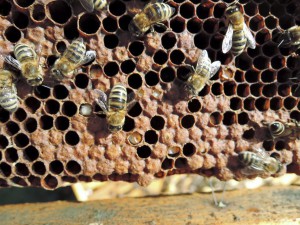 The AMM I have are showing hygienic behaviour against mites in the brood. Now I have seen it also in my Carniolan crossings (the picture).
The AMM I have are showing hygienic behaviour against mites in the brood. Now I have seen it also in my Carniolan crossings (the picture).
I don’t do drone brood cutting as I want the mite to continue being a drone parasite in first place and not a worker bee parasite. I’m happy to see more and more of hygienic behavior against the mite, also in drone brood. Now also in the Carniolan crossings.
At last I want to quote Kirk Webster (http://kirkwebster.com):
“Beekeeping now has the dubious honor of becoming the first part of our system of industrial agriculture to actually fall apart. Let’s stop pretending that something else is going on. We no longer have enough bees to pollinate our crops. Each time the bees go through a downturn, we respond by making things more stressful for them, rather than less – we move them around more often, expose them to still more toxic substances, or fill the equipment up again with more untested and poorly adapted stock. We blame the weather, the mites, the markets, new diseases, consumers, the Chinese, the Germans, the (fill in your favorite scapegoat), other beekeepers, the packers, the scientific community, the price of gas, global warming – anything rather than face up to what’s really happening. We are losing the ability to take care of living things.”
We are at big risk losing the ability to take care of living things. Thank you everyone who is helping me to improve myself as a beekeeper.
